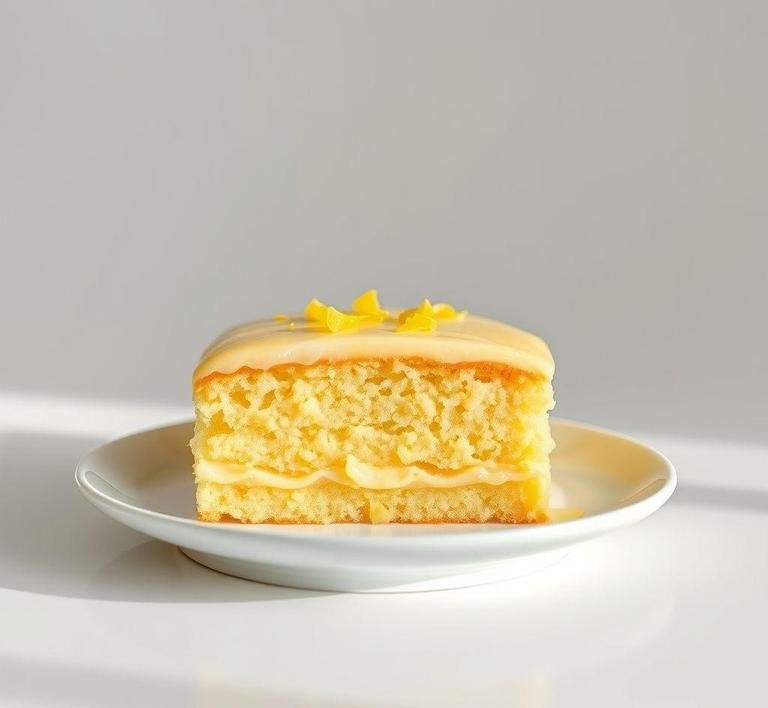Mary Berry’s Lemon Yoghurt Cake is a delightful, moist, and tangy dessert that combines the lightness of a sponge with the fresh zest of lemon. Created by one of the UK’s most beloved bakers, Mary Berry, this cake is known for its ease of preparation and the balance of flavors it offers. The cake uses yoghurt as a key ingredient, which not only provides a subtle tanginess but also contributes to a wonderfully moist texture. The addition of lemon zest and juice infuses the cake with a refreshing citrusy kick, while the yoghurt helps keep the crumb light and tender.
Mary Berry’s Lemon Yoghurt Cake is often praised for its simplicity and versatility, making it perfect for any occasion, from afternoon tea to a casual family gathering. The cake has become a favorite in many households due to its light, airy texture, making it an excellent option for people who enjoy cakes that aren’t too heavy but still full of flavor.
The recipe doesn’t call for extravagant ingredients or complicated techniques, making it ideal for both beginner and experienced bakers. It offers a burst of citrus flavor without being overwhelmingly sweet, which makes it a refreshing alternative to richer cakes. Whether you’re serving it with a dollop of cream, a dusting of powdered sugar, or even a light glaze, this cake always seems to impress.
Mary Berry’s Lemon Yoghurt Cake Recipe
Ingredients Needed

The ingredients for Mary Berry’s Lemon Yoghurt Cake are simple, yet they come together beautifully to create a cake that’s both light and flavorful. Here’s what you’ll need:
- Plain flour (self-raising works too) – The flour is the base for the cake, providing structure. If using plain flour, ensure you add baking powder to help the cake rise. Self-raising flour already contains the necessary leavening agents.
- Caster sugar – Caster sugar is preferred because it dissolves quickly and helps the cake’s texture remain light and airy.
- Greek yoghurt – The star ingredient that gives the cake its moistness. Greek yoghurt also has a thicker consistency, which helps the cake rise properly. The tangy flavor from the yoghurt complements the lemon perfectly.
- Lemon zest and juice – Fresh lemon zest is crucial for bringing a vibrant citrus flavor to the cake. You can use either the juice of the lemon or a combination of juice and zest, depending on how strong you want the lemon flavor.
- Butter – Softened butter contributes to the cake’s rich flavor and texture, giving it a moist, tender crumb. It’s important to have the butter at room temperature so it can blend evenly with the other ingredients.
- Eggs – Eggs provide structure and moisture to the cake. They help with the rise, giving the cake a light and fluffy texture.
- Baking powder – If you’re using plain flour, baking powder is essential to help the cake rise properly.
- A pinch of salt – Salt enhances the flavor of all the other ingredients, bringing out the subtle sweetness and tartness of the cake.
Optional: A light glaze made from icing sugar and lemon juice is often drizzled over the cake once it’s cooled, adding an extra touch of sweetness and a shiny finish.
Equipment Needed
While the ingredients are simple, the right equipment is essential to ensure a smooth and successful baking experience. Here’s a list of the equipment you’ll need:
- Mixing bowls – At least two, one for dry ingredients and one for wet. A large one will allow enough space for the batter to be mixed without spilling.
- Electric mixer or whisk – While you can mix everything by hand, using an electric hand whisk or a stand mixer will make the process faster and easier, especially when creaming butter and sugar together. This step is crucial for achieving a light and fluffy texture.
- Spoon or spatula – A spatula is useful for folding the ingredients together gently, ensuring that the air bubbles you’ve worked to create stay intact.
- Measuring cups and spoons – For accuracy, it’s best to use proper measuring equipment, particularly for the baking powder, lemon juice, and sugar.
- Cake tin – A round or rectangular cake tin, typically about 8 or 9 inches in diameter, works best. It should be greased or lined with baking paper to ensure the cake comes out smoothly after baking.
- Cooling rack – Once baked, it’s important to let the cake cool evenly. A cooling rack helps air circulate around the cake, preventing it from becoming soggy.
- Grater or zester – This is for zesting the lemon, which adds a burst of fragrance to the cake.
- Sieve – If you’re using plain flour, you’ll need a sieve to sift the dry ingredients together to ensure an even texture in the cake.
Instructions To Make Mary Berry’s Lemon Yoghurt Cake
- Preheat the oven: Start by preheating your oven to 180°C (160°C for fan-assisted ovens) or 350°F. Grease your cake tin with butter and line the base with baking paper for easy removal after baking.
- Prepare the dry ingredients: Sift together the flour, baking powder, and salt into a large bowl. This step ensures that the dry ingredients are evenly distributed, which is crucial for achieving an even rise.
- Cream the butter and sugar: In a separate bowl, beat the softened butter and caster sugar together until pale and fluffy. This can take a few minutes with an electric mixer. The mixture should feel light and airy, which will help give the cake its light texture.
- Add the eggs: Add the eggs one at a time, beating well after each addition. This will help emulsify the mixture and ensure it’s smooth.
- Incorporate the wet ingredients: Mix in the yoghurt, lemon juice, and lemon zest, blending until the mixture is smooth and well combined. The yoghurt will give the batter a thicker, creamy texture.
- Combine the wet and dry ingredients: Gently fold in the sifted dry ingredients using a spatula, taking care not to overmix. Over-mixing can deflate the batter, so fold until just combined.
- Bake the cake: Pour the batter into the prepared cake tin and spread it evenly. Place the tin in the preheated oven and bake for about 30-40 minutes, or until the cake is golden and a skewer inserted into the center comes out clean.
- Cool the cake: Let the cake cool in the tin for about 10 minutes before transferring it to a cooling rack. This prevents the cake from becoming too moist on the bottom.
- Optional: Glaze the cake: For an extra layer of lemon flavor and sweetness, mix icing sugar with lemon juice to make a simple glaze. Drizzle it over the cooled cake, allowing it to set before serving.
Tips And Tricks
- Use room temperature ingredients: Ensure that the butter, eggs, and yoghurt are all at room temperature before starting. This allows the ingredients to blend together more easily and results in a smoother batter.
- Don’t overmix the batter: When folding in the dry ingredients, do so gently and carefully. Overmixing can lead to a dense cake that doesn’t rise as well.
- Add a little lemon zest to the glaze: For an even more intense lemon flavor, consider adding a small amount of lemon zest to the glaze. It enhances the citrus profile and gives the glaze a lovely texture.
- Experiment with the texture: If you prefer a more airy, sponge-like cake, add a little extra baking powder. For a denser texture, you can slightly reduce the amount of yoghurt.
- Make ahead: This cake can be made a day in advance. The flavors actually improve as it sits, and it remains moist for a few days when stored in an airtight container.
Mary Berry’s Lemon Yoghurt Cake is a brilliant example of how simple ingredients can create something incredibly delicious. Its balance of sweetness and tanginess, combined with its moist, tender crumb, makes it a favorite for bakers of all levels. Whether you’re new to baking or a seasoned pro, this cake is guaranteed to impress. The straightforward method, paired with the refreshing lemony flavor, makes it a timeless treat perfect for any occasion. By following the simple steps and using a few tips and tricks, you’ll be able to bake a cake that’s both light and flavorful, ideal for afternoon tea or as a delightful dessert after dinner.
Easy Recipe Variations For Mary Berry’s Lemon Yoghurt Cake

Mary Berry’s Lemon Yoghurt Cake is a light, zesty dessert that’s become a favorite in many kitchens, beloved for its moist texture and refreshing flavor. While the classic recipe is perfect on its own, there are plenty of creative variations you can try to personalize this cake to your taste or to cater to different dietary preferences. Here are a few ideas:
1. Berry Infused Lemon Yoghurt Cake
Add a burst of color and flavor by incorporating fresh or frozen berries into the batter. Blueberries, raspberries, or strawberries pair wonderfully with the tangy lemon. Gently fold in a cup of berries just before pouring the batter into the pan, and they’ll soften and burst slightly during baking, creating pockets of juicy sweetness. To enhance the berry flavor, you could also drizzle a berry compote over the top after the cake is baked and cooled.
2. Lemon And Poppy Seed Variation
For those who enjoy a little crunch in their cakes, poppy seeds are an excellent addition. Simply mix 1-2 tablespoons of poppy seeds into the batter before baking. The seeds will add a subtle, nutty texture that contrasts beautifully with the smooth, creamy yogurt base. This variation brings a classic twist that’s reminiscent of traditional lemon poppy seed cakes, but with the added benefit of yogurt for moisture.
3. Gluten-Free Lemon Yoghurt Cake
If you’re looking to make the cake gluten-free, the recipe can be adapted without compromising on taste or texture. Replace the all-purpose flour with a gluten-free flour blend, and ensure that your yogurt is free from any gluten-related additives. You can also opt for almond flour for a slightly denser, nuttier flavor. The structure of the cake may change slightly, but it should remain just as moist and delicious.
4. Lemon And Coconut Yoghurt Cake
For a tropical twist, swap some of the flour for desiccated coconut, and top the cake with toasted coconut flakes for added texture. The rich, nutty flavor of coconut complements the lemon beautifully, giving it an exotic flair. If you’re feeling adventurous, you can even add a splash of coconut milk to the yogurt mixture for an extra layer of coconut flavor.
5. Lemon Lavender Yoghurt Cake
If you want to give your lemon cake a slightly floral twist, try adding dried lavender buds to the batter. Lavender pairs wonderfully with lemon, offering a subtle, fragrant note. You’ll want to use it sparingly, as its flavor can be quite strong. Start with a teaspoon of dried lavender buds and experiment from there. The result is a sophisticated, aromatic cake that’s perfect for a summer tea party or special occasion.
6. Lemon And Ginger Yoghurt Cake
For a warm, spicy kick, add finely grated fresh ginger to the cake batter. The sharpness of ginger contrasts beautifully with the bright lemon flavor. You could also add a teaspoon of ground ginger for an extra depth of flavor, but fresh ginger will provide a more vibrant, natural taste. This version has a slightly more grown-up appeal, perfect for those who enjoy a balance between sweet and spicy.
Storing Leftovers
Once you’ve enjoyed your slice of Mary Berry’s Lemon Yoghurt Cake, you’ll want to store any leftovers properly to ensure it stays fresh and moist for as long as possible.
At Room Temperature
If you plan to eat the cake within 2-3 days, it’s fine to store it at room temperature. Keep the cake in an airtight container or wrap it tightly with plastic wrap to prevent it from drying out. Make sure the container is in a cool, dry spot, away from direct sunlight or heat sources. You can also cover the top with a layer of parchment paper to help maintain moisture.
Refrigeration
If you need to keep the cake for a longer period, refrigeration is your best option. The yogurt in the cake helps it stay moist, but the fridge can dry it out if exposed to air. To prevent this, place the cake in an airtight container, or wrap it tightly with plastic wrap. Stored properly, the cake can last up to a week in the refrigerator. When ready to enjoy, simply bring it to room temperature or lightly warm it up in the microwave for a few seconds.
Freezing
If you have a large batch or want to make the cake ahead of time, freezing is a great option. Slice the cake into individual portions or freeze it whole. Wrap each slice (or the entire cake) tightly in plastic wrap, then place it in a freezer bag or airtight container. The cake will stay fresh in the freezer for up to 3 months. To thaw, simply leave it at room temperature for a few hours or microwave individual slices for a minute or so.
When storing, it’s also important to keep in mind that the glaze (if you choose to add one) may lose some of its glossy finish over time. If you plan to store the cake with the glaze on top, consider adding a fresh glaze or dusting with powdered sugar just before serving.
What To Eat With Mary Berry’s Lemon Yoghurt Cake?
While Mary Berry’s Lemon Yoghurt Cake is delightful on its own, it can be paired with various accompaniments to elevate your dessert experience. Here are some tasty ideas for what to serve alongside it:
1. Fresh Whipped Cream Or Double Cream
A dollop of freshly whipped cream or rich double cream pairs perfectly with the tangy lemon flavor. The creaminess of the whipped cream contrasts nicely with the light, citrusy cake. You could even add a small sprinkle of lemon zest to the whipped cream to enhance the citrusy theme.
2. Fruit Compote Or Fresh Berries
A simple fruit compote made from seasonal fruits like raspberries, strawberries, or blackberries adds sweetness and a touch of acidity to balance the richness of the cake. Fresh berries, on their own or lightly macerated with a touch of sugar, provide a fresh, juicy counterpoint to the dense, yogurt-laced crumb of the cake.
3. Lemon Curd
For an extra burst of lemony goodness, serve the cake with a side of lemon curd. Its tangy, buttery richness complements the citrus notes in the cake and provides an indulgent experience. You can spread it on top of each slice or serve it in small bowls for dipping.
4. Vanilla Ice Cream
A scoop of vanilla ice cream can turn Mary Berry’s Lemon Yoghurt Cake into a more indulgent dessert. The smooth, creamy vanilla ice cream complements the bright, zesty flavor of the cake, and the contrast of temperatures creates an extra level of delight.
5. A Cup Of Tea
A warm, fragrant cup of Earl Grey or green tea makes an excellent beverage to pair with this cake. The light bitterness of the tea balances the sweetness of the cake, while the herbal notes complement the lemon. Alternatively, a chilled glass of sparkling water or lemonade could provide a refreshing, non-alcoholic option.
Conclusion
Mary Berry’s Lemon Yoghurt Cake is the perfect combination of simple ingredients and delightful flavor. The tangy yogurt and zesty lemon create a cake that is light, moist, and incredibly easy to make. Whether you’re sticking to the classic recipe or exploring one of the many variations, you’re sure to end up with a treat that’s both delicious and versatile.
Storing the leftovers is a breeze, and with just a few adjustments, you can keep the cake fresh and tasty for days. Whether served with whipped cream, fresh fruit, or a cup of tea, the possibilities for what to eat alongside this cake are endless, making it a fantastic choice for any occasion.
FAQs
What Ingredients Are Needed For Mary Berry’s Lemon Yoghurt Cake?
Mary Berry’s Lemon Yoghurt Cake requires simple ingredients that are typically found in most kitchens. You will need 175g of self-raising flour, 175g of caster sugar, 175g of natural yogurt, 3 large eggs, 2 tablespoons of sunflower oil, the zest of 2 lemons, and a pinch of salt. For the glaze, you will need the juice of one lemon and 75g of icing sugar.
How Long Does Mary Berry’s Lemon Yoghurt Cake Take To Bake?
The baking time for Mary Berry’s Lemon Yoghurt Cake is around 45 minutes. It should be baked in a preheated oven at 180°C (160°C for fan ovens) or 350°F (Gas Mark 4). It’s important to check the cake by inserting a skewer into the center – it should come out clean when the cake is done.
Can I Make Any Substitutions For Ingredients In Mary Berry’s Lemon Yoghurt Cake?
Yes, you can make a few substitutions in Mary Berry’s Lemon Yoghurt Cake if needed. For example, you can substitute the sunflower oil with vegetable oil or use Greek yogurt instead of natural yogurt for a thicker texture. If you don’t have self-raising flour, you can use plain flour combined with baking powder (approximately 1½ teaspoons of baking powder for every 150g of plain flour). You can also adjust the lemon quantity for a more intense lemon flavor if preferred.


